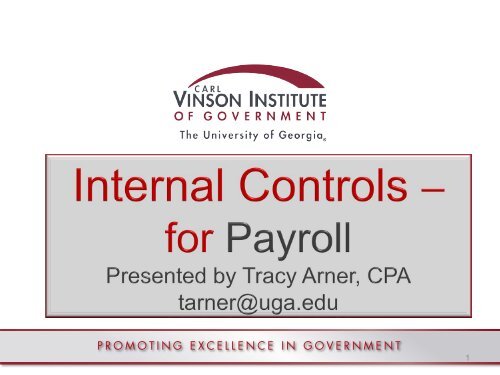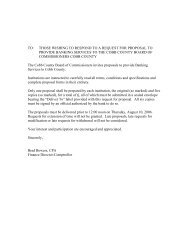Internal Controls for Payroll - Tracy Arner
Internal Controls for Payroll - Tracy Arner
Internal Controls for Payroll - Tracy Arner
- No tags were found...
Create successful ePaper yourself
Turn your PDF publications into a flip-book with our unique Google optimized e-Paper software.
Financial Management Program1
Learning ObjectivesUpon completion of this session , youshould be able to:Recall definition of internal controlUnderstand the importance of internal controlRecite basics of the payroll and benefit cycleExplain <strong>Internal</strong> Control <strong>for</strong> the payroll cycleDiscuss segregation of duties <strong>for</strong> payroll2
INTERNAL CONTROLDEFINITION3
<strong>Internal</strong> Control ReviewCOSOCommittee of SponsoringOrganizations4
<strong>Internal</strong> Control ReviewCOSO’s definition of internal control:<strong>Internal</strong> control is a process, effectedby an entity’s board of directors,management and other personnel,designed to provide reasonableassurance regarding the achievementof objectives in the followingcategories:5
<strong>Internal</strong> Control ReviewDefinition of internal control continued:Operations - effectiveness and efficiency ofoperationsReliability of financial reportingCompliance with applicable laws andregulations6
COSO’s Integrated Framework<strong>Internal</strong> control is carried out by people.– Objectives/control mechanisms establishedby people– Employees must know responsibilities/limitsof authorityManagementObjectivesEmployeesDutiesPer<strong>for</strong>manceOf Duties7
COSO’s Integrated Framework<strong>Internal</strong> control can only provide reasonableassurance– Nobody’s perfect—human decision-makingflawed– Cost outweighs benefits of installing control– Collusion possible– Management override8
<strong>Internal</strong> Control Components9
<strong>Internal</strong> Control Components1 st component, Control EnvironmentIntegrity and ethical valuesgifts and gratuities.pdfUGA exampleCommitment to competenceManagement’s philosophy and operating style(Tone at the Top)Assignment of authority and responsibilityHuman resource policies and practices10
<strong>Internal</strong> Control Components2 nd Component, Risk AssessmentDefined by COSO –Risk assessment is the identification andanalysis of relevant risks to achievement of theobjectives, <strong>for</strong>ming a basis <strong>for</strong> determining howthe risk should be managed.11
Risk AssessmentA precondition to risk assessment is theestablishment of objectives. COSOframework objectives are organized intothree categories:Operational ObjectivesFinancial ReportingObjectivesCompliance Objectives12
Risk AssessmentRisks are eventsthat threaten theaccomplishmentof objectives.Risk assessment is the process ofidentifying, evaluating and determining howto manage these events.13
<strong>Internal</strong> Control Components3 rd Component, Control ActivitiesControl activities are the methods used toreduce risk identified during the riskassessment process.14
Control ActivitiesControl activities includepolicies and proceduresCOSO’s Framework offers the followingcontrol activities commonly per<strong>for</strong>med bypersonnel at various levels.15
Control Activities‣ Top Level Reviews‣ Direct Functional Management‣ In<strong>for</strong>mation Processing‣ Physical <strong>Controls</strong>‣ Reconciliations‣ Segregation of Duties16
<strong>Internal</strong> Control Components4 th Component, In<strong>for</strong>mation andCommunicationAn organization needs to make sure thattypes of communications used are broadbased,useful, reliable and continuous.17
<strong>Internal</strong> Control Components5 th Component, MonitoringEnsures that the internal controls operateas intended.– Ongoing Monitoring– Separate Evaluations18
Ongoing Monitoring• Comparison of employees working tothose receiving paycheck• Response to auditor recommendationsto strengthen internal controls• Employees restate periodically that theyunderstand and comply with code ofconduct• Employees regularly per<strong>for</strong>m criticalcontrol activities19
Separate EvaluationsIs I/C system evaluated byexternal/internal auditors?– If so, how often?– Is the process appropriate?– Is internal control system documentationappropriate and adequate?20
COSO Update – 1 st Quarter 2013Concepts that remain the same– Definition of internal control– 5 components– Criteria used to assess effectiveness– Use of judgment in evaluating effectiveness21
COSO Update – 1 st Quarter 2013Concepts added• Codification of principles <strong>for</strong> developing andevaluating the effectiveness of <strong>Internal</strong><strong>Controls</strong>• Expanded financial reporting objective toaddress internal and external, financial andnon-financial reporting objectives• Increased focus on operations, complianceand non-financial reporting objectives basedon user input22
COSO Update Timelinewww.coso.org2010 2011 2012Sept - Jan Feb - Oct Dec - Mar Apr - DecAssess & SurveyStakeholdersDesign &BuildPublicExposureFinalizeReleased first quarter 201323
Summary of UpdatesCodification of 17 principles embedded in the original FrameworkControl Environment1. Demonstrates commitment to integrity and ethical values2. Exercises oversight responsibility3. Establishes structure, authority and responsibility4. Demonstrates commitment to competence5. En<strong>for</strong>ces accountabilityRisk Assessment6. Assesses fraud risk7. Identifies and analyzes significant change8. Specifies relevant objectives9. Identifies and analyzes riskControl ActivitiesIn<strong>for</strong>mation &CommunicationMonitoring Activities10. Selects and develops control activities11. Selects and develops general controls over technology12. Deploys through policies and procedures13. Uses relevant in<strong>for</strong>mation14. Communicates internally15. Communicates externally16. Conducts ongoing and/or separate evaluations17. Evaluates and communicates deficiencies24
IMPORTANCE OF INTERNALCONTROLS25
Meet objectivesSecurity of assetsPreserve integritySeveralvaluablereasons <strong>for</strong><strong>Internal</strong><strong>Controls</strong>Prevent errorsProtect employeesComplianceChecks and balances26
• Most state laws require governments tohave annual audits of their financialstatements in accordance withGenerally Accepted GovernmentAuditing Standards (GAGAS).• GAGAS requires reporting on internalcontrols27
<strong>Internal</strong> Control and Single Audits• When expending Federal assistance ofmore than $500,000, a governmentmust undergo an A-133 audit or aSingle Audit.• Single audit requires auditee to maintaina system of internal controls28
Can the COSO Framework and the fiveinterrelated components of an effective internalcontrol system be used in the deterrence offraud?ABSOLUTELY29
Lack of adequate internal controls isone of the most commonly citedreasons that fraud occurs within anorganization.FRAUD30
PAYROLL AND BENEFITACCOUNTING OVERVIEW31
Employee Earnings• Determined by agreement between employer andemployee• Salary schedule– Type of position– Steps and years of experience• Employees pay examples:– Annual salary/prorated over pay periods– Hourly rates• Pay periods vary—monthly, semimonthly, biweekly orweekly• FLSA—150% regular rate <strong>for</strong> +40 hours with certainexemptions32
Employee Earnings• Time sheet– Basis of periodic payroll• Contents of time sheet– Employee name and number– Pay period– Dates worked– Number of hours worked– Account distribution– Signatures• Employee• Employer33
<strong>Payroll</strong> Journal• Special Journal• Sometimes call <strong>Payroll</strong> Register• Common contents:– Name of employee– Expenditure/expense classifications– Gross payroll– Adjustments to gross payroll– Adjusted gross payroll– Net payroll34
<strong>Payroll</strong> Deductions and• Social security tax• Federal Income Tax• State Income Tax• Deferred compensation• Pension plans• Insurance• Other miscellaneousWithholdings35
Recording the <strong>Payroll</strong>36
Recording Employer’sShare of Benefits37
Earnings Records38
PAYROLL PROCESS ANDINTERNAL CONTROLOBJECTIVES39
Defining <strong>Payroll</strong> Process• Personal Services = Big Bucks• Expenditure includes– Adjusted gross pay– Employer’s share of benefits• <strong>Payroll</strong> department– Pays employees• Strong internal controls needed40
<strong>Payroll</strong> Cycle41
<strong>Payroll</strong> Cycle42
Control Objectives• Control operations– Establish levels of authority– Provide approval <strong>for</strong> transactions– Provide feedback to approvers• Safeguard assets– Loss or damage– Waste, inefficiency, error, theft or fraud43
Control Objectives• Provide adequate in<strong>for</strong>mation– Timely– Reliable– Supports control structure44
7 Supplementary Objectives• All transactions are recorded• Authorize only valid transactions/protectfrom invalid transactions• Record only valid transactions/preventrecording of invalid transactions• Value transactions correctly/protect fromincorrect calculations and errors in recording45
7 Supplementary Objectives• Recorded transactions are classifiedcorrectly using Chart of Accounts• Record transaction in timely manner• Transactions recorded to subsidiary ledgersand posted to general ledgerAlan Trenerry, Principles of <strong>Internal</strong> Control (Sydney: UNSW Press, 1999) 9-10.46
Control Objectives <strong>for</strong><strong>Payroll</strong>1. <strong>Payroll</strong> transactions are preapproved orauthorized2. Only valid transactions are recorded andthey are recorded in proper period3. Valid transactions are accurate, agreewith source documents and recorded ona timely basis47
Control Objectives <strong>for</strong>4. Recorded transactions– Represent economic events that actuallyoccurred– Are lawful in nature<strong>Payroll</strong>– Are executed in in accordance withmanagement’s general authorization48
Control Objectives <strong>for</strong><strong>Payroll</strong>5. Access to payroll records are controlled– Restricted to authorized personnel6. Proper segregation of duties49
<strong>Internal</strong> Control Components50
Control Environment/<strong>Payroll</strong>• Control Environment– Published code of ethics required to be readand acknowledged by employees• Only employees that possess requiredknowledge and skills should be hired• Employees should be supervised byqualified personnel• Job descriptions should be updated withrequired skills and knowledge51
Control Environment/<strong>Payroll</strong>• Management has ongoing commitment toongoing education and training <strong>for</strong>employees in the payroll department– Especially regarding federal and state taxissues and laws52
<strong>Internal</strong> Control Components53
Risk Assessment andObjective No. 1: AuthorizationRisks:• Hiring an unapproved employee May not be legally eligible• Overspending budget• Hiring an unqualified employee• Incorrect classification <strong>for</strong> benefitscould result in higher costs<strong>Payroll</strong>54
Risk Assessment andObjective No. 2: Safeguarding AssetsRisks:<strong>Payroll</strong>• Errors in payroll process due to hiringunqualified employee• Interest and penalties• Fictitious employees added to payroll55
Risk Assessment and<strong>Payroll</strong>Objective No. 2: Safeguarding AssetsRisks:• Incorrect employee classification– Employee vs independent contractor– Exempt vs nonexempt• Leave taken not properly reported56
Risk Assessment and<strong>Payroll</strong>Objective No. 3: Accurate, reliable and timelyin<strong>for</strong>mationRisks:• Salary/Pay rate not correct• Hours/pay period inaccurately entered• Deduction entered improperly• Not posted to general ledger• Taxes/benefits not paid within required time57
<strong>Internal</strong> Control Components58
Control Activities <strong>for</strong> <strong>Payroll</strong>Four Categories of Control Activities• Hiring• Documentation• Authorization• Reconciliation59
Control Activities <strong>for</strong> <strong>Payroll</strong>• Written process <strong>for</strong> hiring– Budget approval– Authority to advertise– Appropriate applicant in<strong>for</strong>mation– Established selection process– Formal job offering (Letter)• Pay rate• Benefits provided• Status• FLSA classification60
Control Activities <strong>for</strong> <strong>Payroll</strong>Four Categories of Control Activities• Hiring• Documentation• Authorization• Reconciliation61
Control Activities <strong>for</strong> <strong>Payroll</strong>• Documentation—completethe <strong>for</strong>ms– Personal data– Form I-9 (Employment EligibilityVerification)– Form W-4 (Federal Tax Withholding)– Form G-4 (State Tax Withholding)– Benefit <strong>for</strong>ms– Retirement plan <strong>for</strong>ms– Other <strong>for</strong>ms62
Control Activities <strong>for</strong> <strong>Payroll</strong>Four Categories of Control Activities• Hiring• Documentation• Authorization• Reconciliation63
Control Activities <strong>for</strong> <strong>Payroll</strong>• Authorization– Required to ensure that only validtransactions are entered into payroll system• Time sheets signed by employee and supervisor– Supervisor’s approval = authorization to pay and certifiestime recorded is actual time worked.• <strong>Payroll</strong> should be authorized by supervisor– Verify that all supporting documentation is present priorto approving payroll– Could be manual or electronic approval64
Control Activities <strong>for</strong> <strong>Payroll</strong>Four Categories of Control Activities• Hiring• Documentation• Authorization• Reconciliation65
Control Activities <strong>for</strong> <strong>Payroll</strong>• Reconciliations– Hours worked on time sheets = summary ofhours worked in payroll system– Adjusted Gross Salary - No variations unlessadjustments to pay– Taxable Wages - Adjusted gross wages lesspre-tax deductions– Benefits and Deductions– # of employees66
Control Activities <strong>for</strong> <strong>Payroll</strong>• Checklist easy way to showcompleted tasks• Also need to reconcile generalledger accounts afterwithholdings are paid67
<strong>Internal</strong> Control Components68
In<strong>for</strong>mation/Communication of <strong>Payroll</strong>• Enrollment periods <strong>for</strong> benefits• Pay periods and dates (cutoff)• Holidays• Furlough days• Personnel policies and procedures• Salary in<strong>for</strong>mation• Benefits payable due dates• Tax withholding due dates69
<strong>Internal</strong> Control Components70
Monitoring and <strong>Payroll</strong>• Are controls operating as intended• Unmonitored controls deteriorate over time• Monitoring should be ongoing71
Ongoing Monitoringand <strong>Payroll</strong>• Supervisory activities:‣Preventive control‣Detective control‣Examples:‣Reconciliations of payroll amounts‣Initial and date face of reconciliation‣Review employee in<strong>for</strong>mation change <strong>for</strong>ms <strong>for</strong>accurate and timely posting72
Monitoring and <strong>Payroll</strong>• Separate Evaluations– Completed by persons outside of operationsafter the fact• External auditors• <strong>Internal</strong> auditors• Objective– <strong>Internal</strong> controls functioning properly– Provide communication tools <strong>for</strong> deficiencies73
SEGREGATION OF DUTIES74
What Is Segregation of Duties?• Segregation of duties (SoD) meansseparating the record-keeping functionfrom the operational responsibility of thatactivity and from those who exercisephysical control over the records75
What Is Segregation of Duties?DeliberatefraudmoredifficultLikely thatinnocenterrors willbe foundUsed to ensurethat errors orirregularities areprevented ordetected on atimely basis byemployees in thenormal course ofbusiness76
Categories of Duties to be Segregated77
Evaluating Segregation of DutiesAsk yourself…If I make an error in my work,will someone downstream ofme detect it be<strong>for</strong>e it becomesa major issue <strong>for</strong> managementand the taxpayers to readabout?78
Evaluating Segregation of DutiesFunction that is indispensable,potential subject to abuseDivide function into separatestepsAssign each step to a differentperson or different department79
Evaluating Segregation of DutiesAt a minimum, no person should be able toper<strong>for</strong>m more than two of the functions. Thematrix illustration below presents various waysto assign responsibilities that are less than theoptimum.80
Mitigating or Compensating <strong>Controls</strong>• Reduces the risk of an existing or potentialcontrol weakness resulting in errors andomissions• Compensating controls are less desirablethan the segregation of duties• More resources are required to investigateand correct errors and to recover losses81
Mitigating or Compensating<strong>Controls</strong>• Types of compensating controls that canbe implemented:– Review reports of detail transactions– Review selected transactions– Take periodic asset counts– Check reconciliations82
Mitigating orCompensating<strong>Controls</strong>‣Management per<strong>for</strong>msthe procedure‣Compensating controlscannot be delegated83
Segregation of Duties Checklist84
Segregation of Duties85
Segregation of Duties86
www.vinsoninstitute.org©2012 The Carl Vinson Institute of Government. All rights reserved.87




